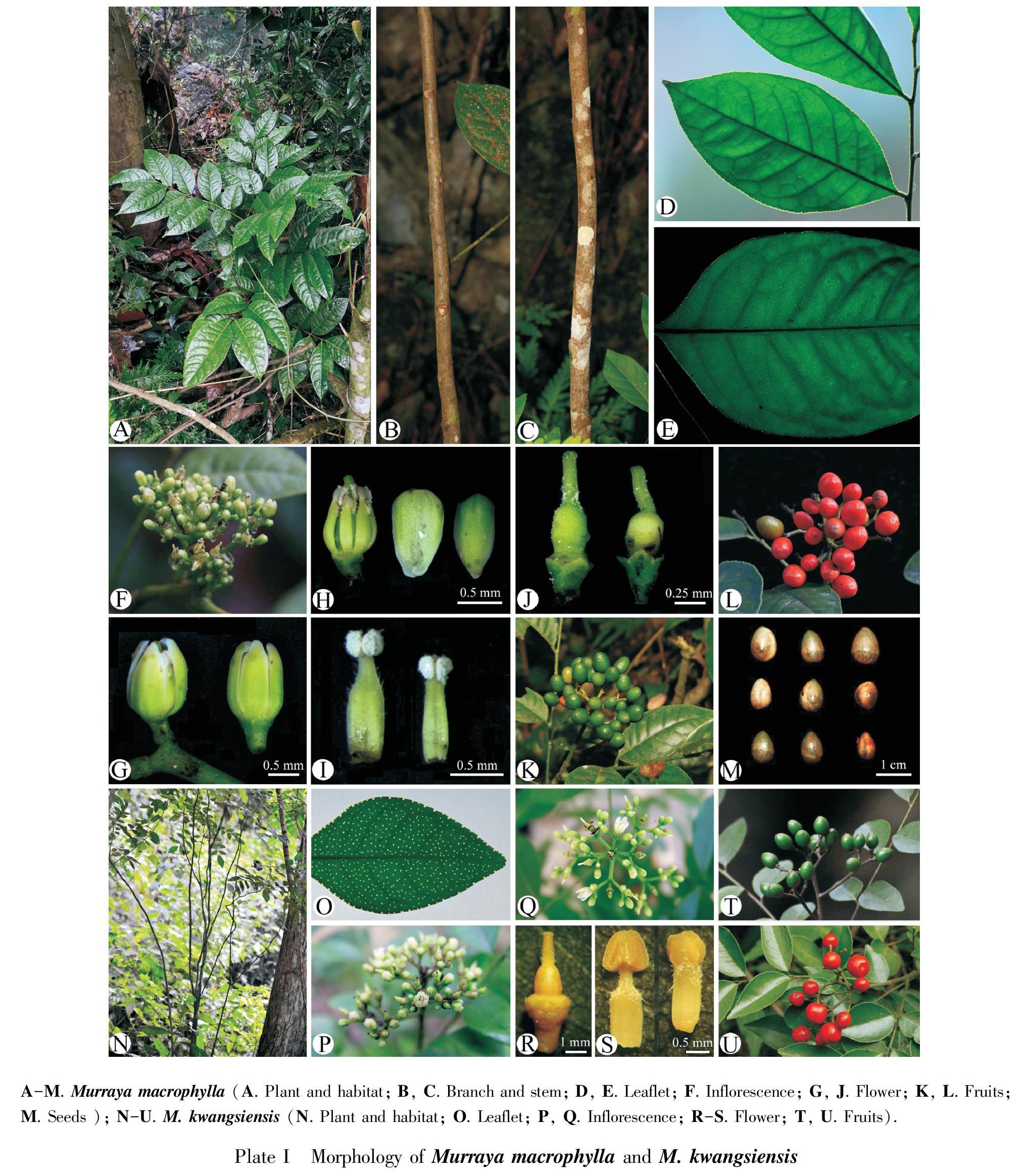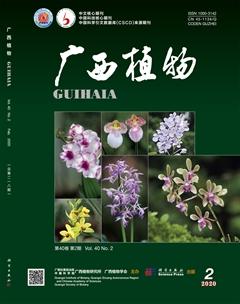大叶九里香,芸香科新等级组合及生物学特征补述英文
牟凤娟 胡秀 马士祝 李一果


Abstract: To clarify the systematic relationship between Murraya kwangsiensis (C. C. Huang) C. C. Huang var. macrophylla C. C. Huang and M. kwangsiensis (C. C. Huang) C. C. Huang var. kwangsiensis (Rutaceae, Murraya) as well as its taxonomic status, several species of Murraya were studied on taxonomy, by the comprehensive research means, such as literature access, specimen identification, field surveys, cultivation observations and microanatomy experiments. The results indicate that M. kwangsiensis var. macrophylla is obviously different from M. kwangsiensis var. kwangsiensis on many morphological characteristics, such as leaves, flowers and fruits, therefore, this taxon should be an independent species, and a new combination and rank Murraya macrophylla (C. C. Huang) F. J. Mou is proposed here; the morphological characteristics and the distribution of M. macrophylla are first described comprehensively; the pinnate leaves and leaflets of this species are the biggest in the genus Murraya, and it is more close to M. glabra (Guillaumin) Swingle endemic to Vietnam; many morphological characteristics, such as the largest leaflets, veins adaxially sunken and wrinkled leaflets, all make this species obviously different from other Murraya species. The taxon M. macrophylla is a independent species rather than a variety of M. kwangsiensis, and this new opinion about the systematic status of M. macrophylla is helpful to reconstruct the phylogenic relationship of the genus Murraya and to probe into the systematic relationship among species.
Key words: Murraya kwangsiensis, M. macrophylla, biological characteristics, new rank, new combination, Rutaceae
摘要: 为理清芸香科(Rutaceae)九里香属(Murraya)中大叶九里香[M. kwangsiensis (C. C. Huang) C. C. Huang var. macrophylla C. C. Huang]与其原变种广西九里香[M. kwangsiensis (C. C. Huang) C. C. Huang var. kwangsiensis]间的系统关系及其分类学地位,采用综合文献查阅、标本鉴定、野外实地调查、栽培观察及显微解剖等多种方法对九里香属植物数个种类进行分类学相关研究。结果发现:大叶九里香在叶片、花、果实等形态特征方面与广西九里香间的差异极大,故将其处理为一个独立的种,并提出新等级组合Murraya macrophylla (C. C. Huang) F. J. Mou;首次对大叶九里香的形态特征及分布进行详尽描述;该物种的羽状复叶及小叶均为九里香属中最大者,更接近仅分布于越南的光叶九里香[M. glabra (Guillaumin) Swingle],但其較大的小叶、叶面叶脉下凹且叶片皱缩等特征使其明显不同于九里香属其他种类。大叶九里香是一个独立种而非广西九里香的变种,此关于大叶九里香分类地位的新观点有助于整个九里香属的系统发育关系重建及种间系统关系的深入探索。
关键词: 广西九里香, 大叶九里香, 生物学特征, 新等级, 新组合, 芸香科
Genus Murraya J. Koenig (under the name Murraea) was first published based on a single species, Murraea exotica L., while Bergera L. was described based on B. koenigii J. Koenig (Linnaeus, 1771). Later taxonomists unanimously treated Murraya and Bergera as congeneric, and Murraya has been conserved against Chalcas L., though Chalcas was earlier published (Linnaeus, 1767). Most species of Murraya distribute in South China and Indo-Malaysia, although some species can reach Sri Lanka, New Caledonia and Northeast Australia (Swingle, 1938; Swingle & Reece, 1967). Tanaka (1929) recognized eight species and two varieties in the genus (under the name Chalcas). The species of Murraya were classified into two or three groups, and eleven species and four varieties were re-cognized (Tanaka 1929; Swingle 1938; Swingle & Reece, 1967; But et al., 1986). Subsequent studies on Chinese materials led to the addition of one new species Murraya tetramera C. C. Huang (Huang, 1959), one new combination M. kwangsiensis (C. C. Huang) C. C. Huang and one new variety M. kwangsiensis var. macrophylla C. C. Huang (Huang, 1978). Nine species or one variety are endemic to China (Huang, 1997; Zhang et al., 2010). Considering the differences of chemical constituents between two sections of Murraya, M. kwangsiensis var. macrophylla was included into sect. Bergera, along with M. kwangsiensis var. kwangsiensis (But et al., 1986), otherwise, the former should belong to sect. Murraya as an independent species, based on the morphological cha-racteristics of the leaf epidermis of nine Chinese species of Murraya (Zou et al., 1997, 1999). At present, extremely limited findings are controversial concerning the taxonomic status and systematic position of this taxon.
The morphological descriptions of few morphological characteristics, only size of leaflet blades and fruit color are described after the publication of M. kwangsiensis var. macrophylla, and always is a variety of M. kwangsiensis (Huang, 1978, 1997; Zhang et al., 2010). Totally, there are ten specimens including type in three herbaria, namely IBK, GXMI and GXMG. Owing to lacking information, little is known about the taxon. For the above reasons, this taxon needs further studies on field researches and other experiments. During conducting the program “The taxonomic revision and systimatics of Murraya s. l.”, several populations of M. kwangsiensis var. macrophylla were only found in Guangxi.
1Materials and Methods
All specimens of Murraya kwangsiensis var. macrophylla and M. kwangsiensis var. kwangsiensis preserved in IBK, GXMI, GXMG, KUN, IBSC, SYS, PE and NAS were carefully studied for collecting information and many morphological characteristics. From 2016 to 2017, field researches such as morphological characte-ristics, growth state, population status and ecological condition were finished in Longzhou County, Daxin County and Napo County, Guangxi. For successively observing the biological and phenological characteristics of this species, a few plants from Napo and Daxin counties were transplanted in the greenhouse of Southwest Forestry University in 2016 and 2017 respectively.
During 2017-2018, flowering and fruiting were intensively investigated in cultivated environments; leaves, flowers and fruits are studied by microanatomy methods.
2Results and Analyses
2.1 Murraya macrophylla (C. C. Huang) F. J. Mou et D. X. Zhang comb. et stat. nov. (Plate I) 大葉九里香
Basionym: Murraya kwangsiensis (C. C. Huang) C. C. Huang var. macrophylla C. C. Huang, in Acta Phytotax. Sin. 16(2): 85 (1978).
Type: China, Guangxi, Daxin, (Z. J. Li 3198, Holotype: IBK! barcode IBK00191042).
Additional specimens examined: China, Longzhou, X. F. Deng 10571 (IBK), H. Q. Li 40099 (IBK); Daxin, F. J. Mou 618, 619 (SWFC); Jingxi, Y. D. Peng 451025141014005LY (GXMG); Napo, D. Fang et al. 0885 (GXMI), D. Fang et al. 3-15482 (GXMI), D. X. Nong et al. 451026130722029LY (GXMI, GXMG), B. Y. Huang 451026141015067LY (GXMG), X. Y. Huang 451026131127023LY (GXMG), F. J. Mou 543, 550, 552, 624, 625 (SWFC).
Shrub, high up to 2 m. Young branches, rachises, petioles and petals dispersed with very prominent oil glands. Compound leaves; rachises rather thin, about 12-30 cm long; leaflets 3-9, alternate; leaflet blades thick chartaceous,a few oil glands in the mesophyll; 7-20 cm×4-10 cm, slightly inequilateral and pointed at the base, abruptly acuminate at the tip, very slightly denticulate at the margin, with a oil gland at every tooth joint; glabrous, glossy and deep green upper, light yellow-green lower, brown when dried; lateral veins 6-9 pairs, sunken on upper surface, prominent on lower surface; petiolules cylindric, glabrous, 8-16 mm long; petioles cylindric, glabrous, prominently swollen at the base. Inflorescences terminal, cymes with a few small flowers, shorter than leaves; pedicels shorter than the flowers, with 2-4 small bracts at the base; flower buds broad ovate or oblong, 4 mm × 2.5 mm, yellow white, fragrant; calyx 4-connate, very shortly ciliate sepal with a big oil gland at the base; petals 4 mm × 1 mm, glabrous, oblong. Stamens 10, alternately shorter, 3 or 2 mm long; filaments constricted gradually upper 1/2 and pubescent above; anthers attached by the back, oval, with a few hairs; disk extremely short. Ovary cylindric, glabrous, with a few oil glands, distinctly constricted at about 1/3 from the apex; style longer than ovary, with very short hairs; stigma distinct. Berry oval, diameter 4-7 mm, smooth, with dense glands, red when ripe, containing 1-2-seed, mostly 1-seed. Flowering Jun.-Jul.; fruiting Aug.-Dec.
Distribution: China, Southwest Guangxi (Longzhou, Daxin, Jingxi, Napo).
Habitat: Under forestry of limestone hill or valley forests, humid, shaded; alt. 550-1 400 m.
2.2 Recognition of the status of Murraya macrophylla
Species Murraya macrophylla shares few similarities of flowers with M. kwangsiensis, but both are so different in many morphological characteristics (Plate I; Table 1). However, this taxon is more similar to M. glabra from Vietnam on leaf morphological characteristics, but different in having less oil glands in the mesophyll, smaller cyme, less flowers and fruits. In a word, the taxon should be a species instead of a variety of M. kwangsiensis and placed under sect. Bergera based on the morphology.
3Discussion and Conclusion
Since published, Murraya macrophylla is always treated as a variety of M. kwangsiensis (Huang, 1978, 1997; Zhang et al., 2010). According to the studies of specimens and field research, it is found that the roots, stems and mature branches of M. macrophylla are gray-brown instead of gray-white, the same as these of M. kwangsiensis, which is so different from description of Zou et al. (1997, 1999) and means that the taxon should be included into sect. Bergera instead of sect. Murraya. The species is more similar to M. glabra in the light of leaf morpho-logy and is more close to other species from Vietnam, namely M. glabra and M. stenocarpa instead of M. kwangsiensis, based on phylogeny of the genus Murraya from ITS and six cpDNA sequences (unpublished data). All evidences suggest that M. macrophylla should be separated from M. kwangsiensis as an independent species, which is consistent with opinion of Zou et al. (1997, 1999).
Key of four relative species of Murraya
1. Pinnately compound leaves.
2. Leaflets surface smooth; inflorescences pubescent; calyx 5-connateMurraya kwangsiensis
2. Leaflets surface uneven; inflorescences glabrous; calyx 4-connate.
3. Inflorescences terminal and lateral; petals 4; stamens 8; stigma slightly swollen, yellowM. glabra
3. Inflorescences terminal; petals 5; stamens 10; stigma indistinctM. macrophylla
1. Unifoliate compound leavesM. stenocarpaAcknowledgementsAll authors thanks for the help from these herbaria, IBK (Herbarium, Guangxi Institute of Botany), GXMI (Herbarium, Guangxi Institute of Chinese Medicine & Pharmaceutical Science), GXMG (Herbarium, Guangxi Medical Botanical Garden), KUN (Herbarium, Kunming Institute of Botany, Chinese Academy of Sciences) and IBSC (Herbarium, South China Botanical Garden, CAS), SYS ( Herbarium of Sun Yat-sen University).
References:
BUT PPH, KONG YC, NG KH, et al., 1986. A chemotaxonomic study of Murraya (Rutaceae) in China [J]. Acta Phytotax Sin, 24(3): 186-192. [毕陪曦, 江润祥, 吴锦洪, 等, 1986. 国产芸香科九里香属化学分类 [J]. 植物分类学报, 24(3):186-192.]
HUANG CC, 1959. Preliminary study on Chinese Rutaceae (3) [J]. Acta Phytotax Sin, 8(1): 69-124. [黄成就, 1959. 中国芸香科植物初步研究(三) [J]. 植物分类学报, 8(1):69-124.]
HUANG CC, 1978. Materials of Chinese Rutaceae [J].Acta Phytotax Sin, 16(2): 81-85. [黄成就, 1978. 中国芸香科植物资料 [J]. 植物分类学报, 16(2):81-85.]
HUANG CC, 1997. Angiospermae Dicotyledoneae Rutaceae [M] // Flora Reipublicae Popularis Sinicae: Tomus 43, Vol. 2. Beijing: Science Press: 139-150. [黄成就, 1997. 芸香科 [M] //中国植物志: 第四十三卷第二分册. 北京:科学出版社:139-150.]
LINNAEUS CA, 1767. Mantissa plantarum: Generum editionis VI et specierum editionis Ⅱ [M]. Holmiae: Impensis Direct. Laurentii Salvii: 11, 68.
LINNAEUS CA, 1771. Mantissa plantarum: Altera generum editionis VI et specierum editionis Ⅱ [M]. Holmiae: Impensis Direct. Laurentii Salvii: 554-555, 563.
SWINGLE WT, 1938. A new taxonomic arrangement of the orange subfamily Aurantioideae [J]. J Wash Acad Sci, 28: 530-533.
SWINGLE WT, REECE PC, 1967. The botany of Citrus and its wild relatives (family Rutaceae, subfamily Aurantioideae) [M] // REUTHER W, WEBBER HJ, BATCHEL LD. The Citrus industry. Vol. I. History, world distribution, botany and varieties. Berkeley: University of California Press: 231-240.
TANAKA T, 1929. Chalcas, a Linnean genus which includes many new types of Asiatic plants [J]. J Soc Trop Agric, 1(1): 23-44.
ZHANG DX, HARTLEY TG, MABBERLEY DJ, 2010. Rutaceae [M]//WU ZY, RAVEN PH. Flora of China: Vol. 11. Beijing: Science Press; St. Louis: Missouri Botanical Garden Press: 53-85.
ZOU LX, ZHENG HC, YANG CR, 1997. Progress on research on the genus Murraya [J]. J Pharm Pract, 15(4): 214-219. [邹联新, 郑汉臣, 杨崇仁, 1997. 九里香属植物研究进展 [J]. 药学实践杂志, 15(4):214-219.]
ZOU LX, YANG CR, ZHENG HC, 1999. A SEM observation on taxonomic and pharmacognostical identification of genus Murraya produced in China [J]. Chin J Chin Mat Med, 24(12): 710-714, 762. [鄒联新, 杨崇仁, 郑汉臣, 1999. 扫描电镜技术在九里香属植物生药学和分类学鉴定中的意义 [J]. 中国中药杂志, 24(12):710-714, 762.]
(责任编辑 李莉)

